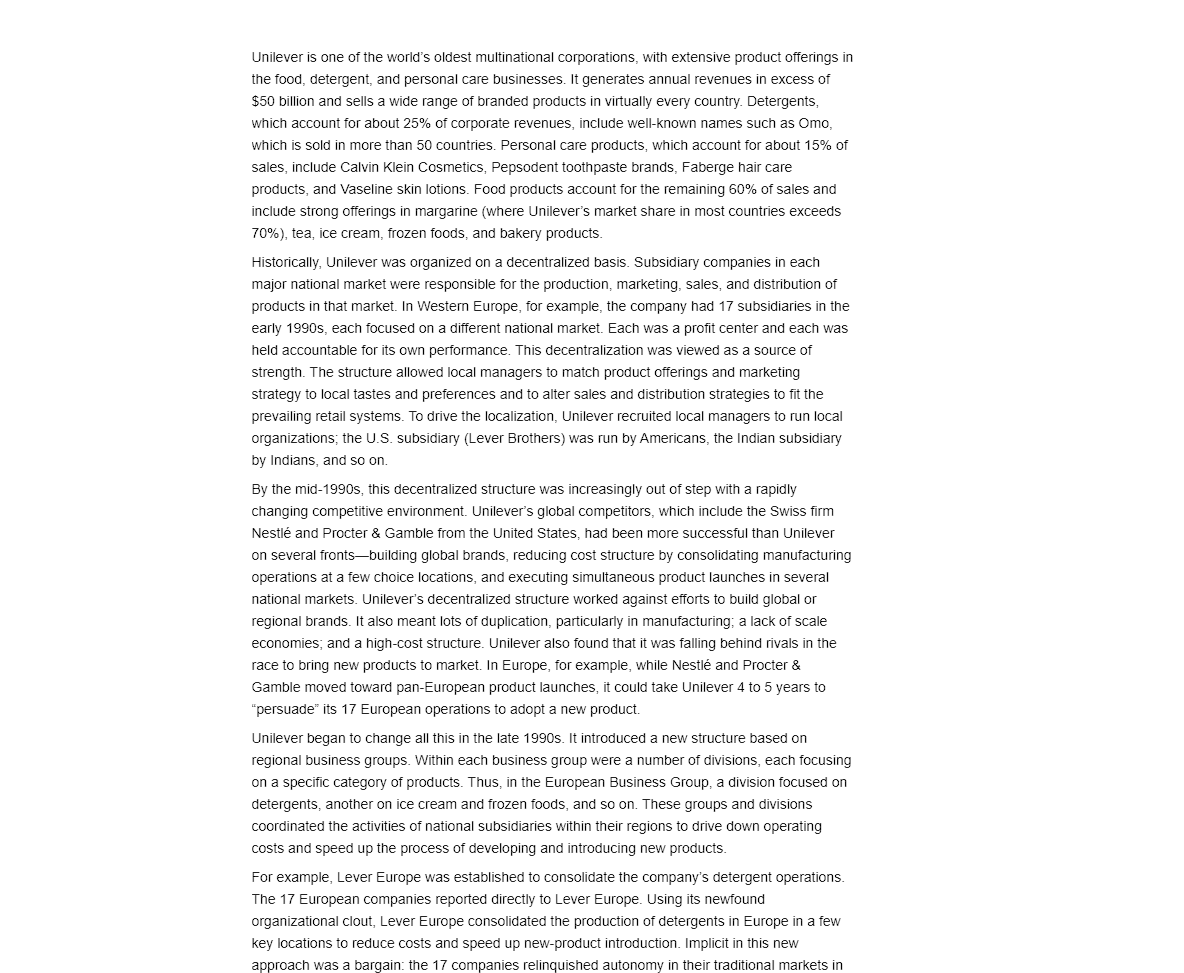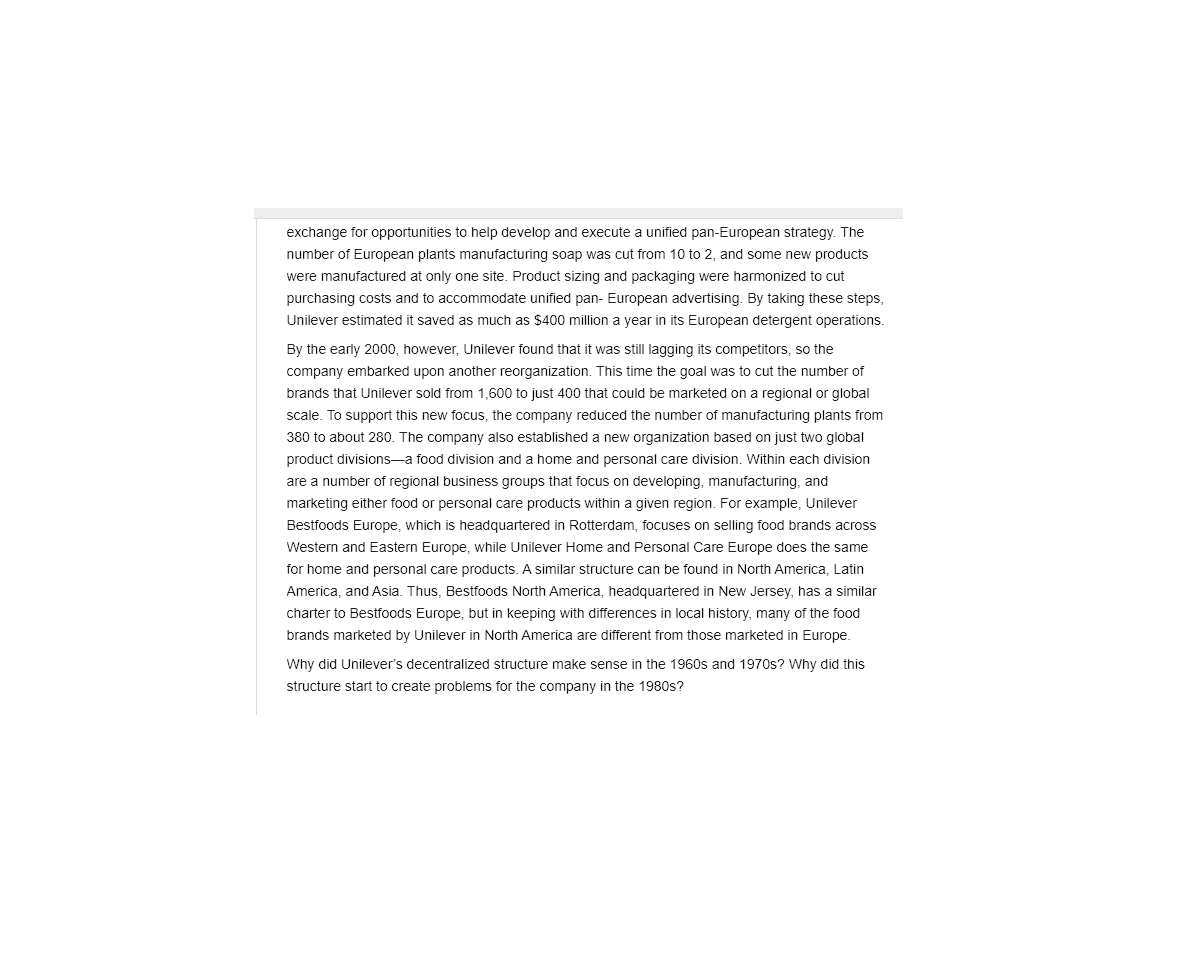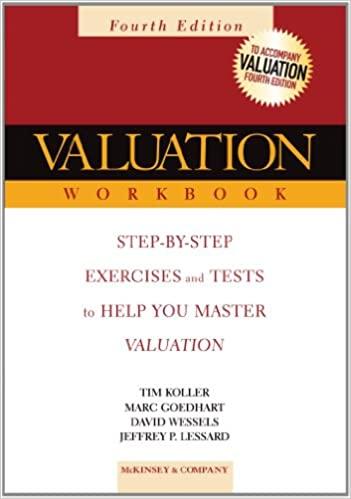Answered step by step
Verified Expert Solution
Question
1 Approved Answer
just answer this question pls ( dont mind the question above this statement) 1.) What was the new structure introduced by Unilever in the mid-1990s?

 just answer this question pls ( dont mind the question above this statement)
just answer this question pls ( dont mind the question above this statement)
1.) What was the new structure introduced by Unilever in the mid-1990s? Why do you think this structure failed to cure Unilevers ills? Explain your answer.
2.)Unilever, in the 1990s, switched to a structure based on global product divisions. What do you think is the underlying logic for this shift? Does the structure make sense given the nature of competition in the detergents and food business?
3.)Prepare a short company background of Unilever (1 or 2 paragraphs only).
Unilever is one of the world's oldest multinational corporations, with extensive product offerings in the food, detergent, and personal care businesses. It generates annual revenues in excess of $50 billion and sells a wide range of branded products in virtually every country. Detergents, which account for about 25% of corporate revenues, include well-known names such as Omo, which is sold in more than 50 countries. Personal care products, which account for about 15% of sales, include Calvin Klein Cosmetics, Pepsodent toothpaste brands, Faberge hair care products, and Vaseline skin lotions. Food products account for the remaining 60% of sales and include strong offerings in margarine (Where Unilever's market share in most countries exceeds 70%), tea, ice cream, frozen foods, and bakery products Historically, Unilever was organized on a decentralized basis. Subsidiary companies in each major national market were responsible for the production, marketing, sales, and distribution of products in that market. In Western Europe, for example, the company had 17 subsidiaries in the early 1990s, each focused on a different national market. Each was a profit center and each was held accountable for its own performance. This decentralization was viewed as a source of strength. The structure allowed local managers to match product offerings and marketing strategy to local tastes and preferences and to alter sales and distribution strategies to fit the prevailing retail systems. To drive the localization, Unilever recruited local managers to run local organizations, the U.S. subsidiary (Lever Brothers) was run by Americans, the Indian subsidiary by Indians, and so on. By the mid-1990s, this decentralized structure was increasingly out of step with a rapidly changing competitive environment. Unilever's global competitors, which include the Swiss firm Nestl and Procter & Gamble from the United States, had been more successful than Unilever on several frontsbuilding global brands, reducing cost structure by consolidating manufacturing operations at a few choice locations, and executing simultaneous product launches in several national markets. Unilever's decentralized structure worked against efforts to build global or regional brands. It also meant lots of duplication, particularly in manufacturing, a lack of scale economies, and a high-cost structure. Unilever also found that it was falling behind rivals in the race to bring new products to market. In Europe, for example, while Nestl and Procter & Gamble moved toward pan-European product launches, it could take Unilever 4 to 5 years to "persuade its 17 European operations to adopt a new product. Unilever began to change all this in the late 1990s. It introduced a new structure based on regional business groups. Within each business group were a number of divisions, each focusing on a specific category of products. Thus, in the European Business Group, a division focused on detergents, another on ice cream and frozen foods, and so on. These groups and divisions coordinated the activities of national subsidiaries within their regions to drive down operating costs and speed up the process of developing and introducing new products. For example, Lever Europe was established to consolidate the company's detergent operations The 17 European companies reported directly to Lever Europe. Using its newfound organizational clout, Lever Europe consolidated the production of detergents in Europe in a few key locations to reduce costs and speed up new-product introduction. Implicit in this new approach was a bargain: the 17 companies relinquished autonomy in their traditional markets in exchange for opportunities to help develop and execute a unified pan-European strategy. The number of European plants manufacturing soap was cut from 10 to 2, and some new products were manufactured at only one site. Product sizing and packaging were harmonized to cut purchasing costs and to accommodate unified pan-European advertising. By taking these steps, Unilever estimated it saved as much as $400 million a year in its European detergent operations. By the early 2000, however, Unilever found that it was still lagging its competitors, so the company embarked upon another reorganization. This time the goal was to cut the number of brands that Unilever sold from 1,600 to just 400 that could be marketed on a regional or global scale. To support this new focus, the company reduced the number of manufacturing plants from 380 to about 280. The company also established a new organization based on just two global product divisionsa food division and a home and personal care division. Within each division are a number of regional business groups that focus on developing, manufacturing, and marketing either food or personal care products within a given region. For example, Unilever Bestfoods Europe, which is headquartered in Rotterdam, focuses on selling food brands across Western and Eastern Europe, while Unilever Home and Personal Care Europe does the same for home and personal care products. A similar structure can be found in North America, Latin America, and Asia. Thus, Bestfoods North America, headquartered in New Jersey, has similar charter to Bestfoods Europe, but in keeping with differences in local history, many of the food brands marketed by Unilever in North America are different from those marketed in Europe. Why did Unilever's decentralized structure make sense in the 1960s and 1970s? Why did this structure start to create problems for the company in the 1980s
Step by Step Solution
There are 3 Steps involved in it
Step: 1

Get Instant Access to Expert-Tailored Solutions
See step-by-step solutions with expert insights and AI powered tools for academic success
Step: 2

Step: 3

Ace Your Homework with AI
Get the answers you need in no time with our AI-driven, step-by-step assistance
Get Started


